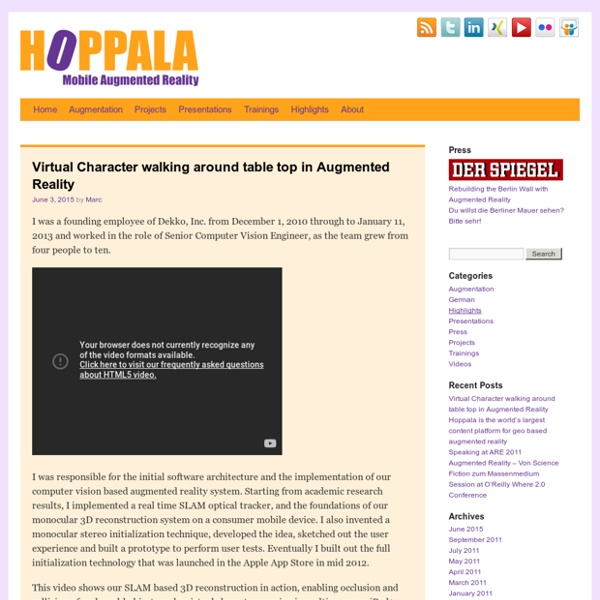



Creation Tools: Series Wrap-Up By Chris Cameron on December 20th 2010 Over the last several weeks here on the Layar blog, we profiled three services for generating Layar content, which we call Layar Creation Tools (or LCTs). While other services exist or are in development, we chose to focus on these three – Skaloop , Hoppala Augmentation and BuildAR – because of their availability and accessibility to users of all skill levels. Each LCT is unique and has its benefits to different users, so we decided to make a matrix that shows which features are available on each LCT. As you can see, Hoppala includes most of the features listed, such as layer actions, 3D objects and custom interaction widgets. Skaloop and BuildAR are simpler LCTs than Hoppala in terms of functionality, but their interface and design is a bit more digestible for more casual users. If you are interested at all in creating Augmented Reality content on Layar, have a look at the matrix below and see which LCT might be right for you.
What is Layar? – Layar It's not a futuristic dream, it’s here now. Augmented reality (AR) is cutting-edge technology that allows for a digitally enhanced view of the real world, connecting you with more meaningful content in your everyday life. With the camera and sensors in a smartphone or tablet, AR adds layers of digital information – videos, photos, sounds – directly on top of items in the world around us. Ready to see what Layar can do for your business? Why Layar Make augmented reality part of your everyday life From exploring a new city with helpful tips to discovering additional content within the pages of a magazine, the possibilities for AR are nearly endless. With AR, it is easy to have a great digital experience on top of interactive magazines, ads, packaging, business cards and other items. What the market says
Find Great Local Deals with Anca 3D’s Groupon Layer By Adriane on March 10th 2011 While coupon-clipping is a practice generally reserved for those who still pay for a print newspaper subscription, collective-buying companies like Groupon and Living Social are growing rapidly. Both companies also now have mobile apps that allow you to view and purchase daily deals on-the-go and redeem them digitally (saving time and trees, yay!). Layar developer and Anca 3D co-founder Juan de la Torre (a recent Canadian transplant from Colombia) used Groupon’s open API to create a layer that displays nearby Groupon deals. Currently, the Groupon API is only available in the US and Canada, so the layer is only available in those countries as well. Hopefully Groupon will get on board and add de la Torre’s AR content to its existing app! Anca 3D is a Columbia and Canada-based Augmented Reality development company co-founded by Juan de la Torre and Andres Cardoso.
Daqri's Elements 4D augmented reality app aims to educate the masses | Cutting Edge Daqri is getting into the Kickstarter game to promote an app aimed at bringing augmented reality into the mainstream. Elements 4D enables an augmented reality experience using six physical blocks engraved with different symbols of the periodic table. Combining the blocks creates various chemical reactions that appear on a tablet or smartphone screen in 3D in the Elements 4D app viewer. "It is the first killer app for augmented reality," the company boasted. "We wanted to design a product from the ground up that had augmented reality [which Daqri calls '4D'] at its core. Up until now it's been layered on top of something and more of an afterthought," said Daqri CEO Brian Mullins. Anatomy 4D, a Daqri app available for iOS and Android, allows users to see detailed 3D images of the human anatomy and bodily systems by pointing a smartphone or tablet at a target image the company provides. Read: The next big thing in tech -- augmented reality
Business Ecosystems » augmented reality The increasing popularity of Augmented Reality apps for smart phone (which means, iPhone and Android: apps for Windows Mobile are still to come) is under the radar of our blog since a (quite) long time and, indeed, we have found that most of the apps available for download are focused on a small number of application fields. According to a classification developed by Gary Hayes, augmented reality applications can be catalogued in 16 different business (we’d rather write service) models. The chart below is useful to understand which apps are more popular and profitable (or, whith a higher commercial value). We believe that our of these 16 service models, we can pick up four or five main models which could be applied or involved in an AR service concept which a strong relationship with telecommunication and social network capabilities: Location layerEnhanced classifiedPersonalized shopping Recognition and TargetingBlended Brand Share Tags: augmented reality
Tons of Classroom Examples Using Augmented Reality with @Aurasma - A Complete How-To Guide! How to Use Augmented Reality in Your Classroomthis post is read best via a desktop due to the embedded video content Augmented reality allows someone to add another layer to an existing image. For example, imagine holding your phone over a poster on the wall as if you were going to take a photo of that poster, and then instantly a video starts playing to offer you additional information about that particular poster. Pretty cool, right? The first time it happens, it seems like magic. After watching the video below, I knew I had to figure this augmented reality thing out. Aurasma is the app I use to create augmented reality. Sharing Aurasma with My Husband's Colleagues Not only is augmented reality amazing, it's also free and easy to do. While waiting for our table to be called for dinner, we were discussing the nice decorations displayed around the reception hall. His colleagues began instantly brainstorming how this could be used for their business. Augmented Reality Vocabulary Step 1:
Two Guys and Some iPads